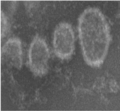Tomato spotted wilt orthotospovirus
Tomato Spotted Wilt Orthotospovirus (TSWV) is a plant pathogenic virus that belongs to the genus Orthotospovirus within the family Tospoviridae. It is known for causing the disease tomato spotted wilt in a wide range of host plants, affecting both agricultural crops and ornamental plants worldwide. TSWV is notable for its broad host range, infecting over 1,000 plant species across more than 80 families, including important crops such as tomato, pepper, lettuce, peanut, and tobacco. The virus is transmitted by thrips, small insects that feed on the sap of plants, making management and control of the disease challenging.
Symptoms[edit]
The symptoms of tomato spotted wilt vary widely depending on the host plant, the age of the plant at the time of infection, and environmental conditions. Common symptoms include:
- Bronzing of leaves
- Ring spots and line patterns on leaves and fruits
- Wilting and stunting of plants
- Necrosis or death of tissue, particularly in the shoot tips
Transmission[edit]
TSWV is primarily transmitted by thrips, specifically the western flower thrips (Frankliniella occidentalis) and the tobacco thrips (Frankliniella fusca). These insects acquire the virus while feeding on an infected plant during their larval stage and can transmit the virus throughout their adult life. Transmission occurs when the thrips feed on the sap of a healthy plant, introducing the virus into the plant's cells.
Management[edit]
Management of tomato spotted wilt focuses on controlling the thrip population and preventing the spread of the virus. Strategies include:
- Cultural control methods such as removing infected plants and weeds that can serve as reservoirs for the virus.
- Using reflective mulches to deter thrips from landing on plants.
- Applying insecticides to control thrip populations, although resistance can be a problem.
- Growing resistant plant varieties where available.
Economic Impact[edit]
The economic impact of TSWV is significant, particularly in the production of susceptible crops such as tomatoes, peppers, and peanuts. Yield losses and the cost of management strategies can be substantial, affecting both large-scale agricultural operations and smallholder farmers.
Research[edit]
Research on TSWV focuses on understanding the virus's biology, transmission mechanisms, and interactions with host plants and vectors. Efforts are also directed towards breeding resistant plant varieties and developing more effective and sustainable management strategies.
-
Tomato with Tomato Spotted Wilt Virus
-
Tomato Spotted Wilt Virus
-
Sweet basil (Ocimum basilicum) - Tomato spotted wilt virus (TSWV)
Ad. Transform your life with W8MD's Budget GLP-1 injections from $75


W8MD offers a medical weight loss program to lose weight in Philadelphia. Our physician-supervised medical weight loss provides:
- Weight loss injections in NYC (generic and brand names):
- Zepbound / Mounjaro, Wegovy / Ozempic, Saxenda
- Most insurances accepted or discounted self-pay rates. We will obtain insurance prior authorizations if needed.
- Generic GLP1 weight loss injections from $75 for the starting dose.
- Also offer prescription weight loss medications including Phentermine, Qsymia, Diethylpropion, Contrave etc.
NYC weight loss doctor appointmentsNYC weight loss doctor appointments
Start your NYC weight loss journey today at our NYC medical weight loss and Philadelphia medical weight loss clinics.
- Call 718-946-5500 to lose weight in NYC or for medical weight loss in Philadelphia 215-676-2334.
- Tags:NYC medical weight loss, Philadelphia lose weight Zepbound NYC, Budget GLP1 weight loss injections, Wegovy Philadelphia, Wegovy NYC, Philadelphia medical weight loss, Brookly weight loss and Wegovy NYC
|
WikiMD's Wellness Encyclopedia |
| Let Food Be Thy Medicine Medicine Thy Food - Hippocrates |
Medical Disclaimer: WikiMD is not a substitute for professional medical advice. The information on WikiMD is provided as an information resource only, may be incorrect, outdated or misleading, and is not to be used or relied on for any diagnostic or treatment purposes. Please consult your health care provider before making any healthcare decisions or for guidance about a specific medical condition. WikiMD expressly disclaims responsibility, and shall have no liability, for any damages, loss, injury, or liability whatsoever suffered as a result of your reliance on the information contained in this site. By visiting this site you agree to the foregoing terms and conditions, which may from time to time be changed or supplemented by WikiMD. If you do not agree to the foregoing terms and conditions, you should not enter or use this site. See full disclaimer.
Credits:Most images are courtesy of Wikimedia commons, and templates, categories Wikipedia, licensed under CC BY SA or similar.
Translate this page: - East Asian
中文,
日本,
한국어,
South Asian
हिन्दी,
தமிழ்,
తెలుగు,
Urdu,
ಕನ್ನಡ,
Southeast Asian
Indonesian,
Vietnamese,
Thai,
မြန်မာဘာသာ,
বাংলা
European
español,
Deutsch,
français,
Greek,
português do Brasil,
polski,
română,
русский,
Nederlands,
norsk,
svenska,
suomi,
Italian
Middle Eastern & African
عربى,
Turkish,
Persian,
Hebrew,
Afrikaans,
isiZulu,
Kiswahili,
Other
Bulgarian,
Hungarian,
Czech,
Swedish,
മലയാളം,
मराठी,
ਪੰਜਾਬੀ,
ગુજરાતી,
Portuguese,
Ukrainian



